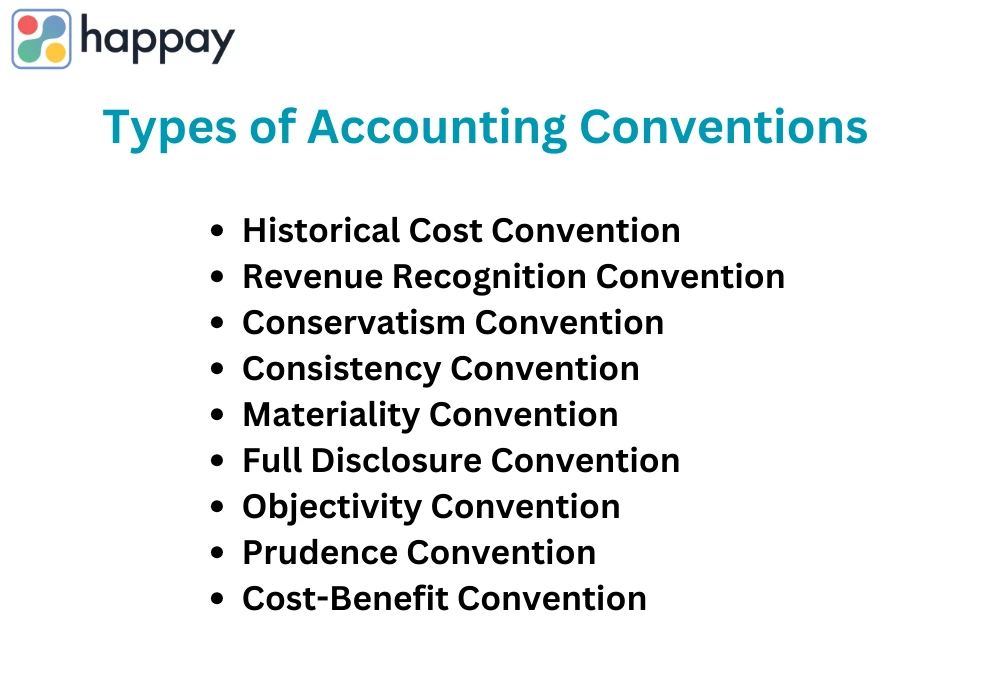Last Updated on November 28, 2025
Introduction
Think about how you follow certain “rules” in your life, whether it’s holding the door open for someone, saying “please” and “thank you,” or stopping at a red traffic light. These rules make our daily interactions smoother, more understandable, and less chaotic.
Accounting conventions, in a sense, are the “rules of the road” for financial reporting. They’re the guiding principles that help companies, big and small, make sense of their numbers and communicate their financial stories to the world. Imagine a world without these rules—financial chaos, right?
But here’s the twist. While accounting conventions might seem rigid, there’s an art to them too. In this blog, we’re going to unravel the mystery behind these conventions. We’ll dive into their advantages, discuss their role in shaping industries, and explore their impact on the global stage.
What is accounting conventions with example?
Accounting conventions, also known as accounting principles or accounting concepts, are fundamental guidelines and rules that dictate how financial transactions are recorded and reported in accounting. These conventions serve as a framework for maintaining consistency and reliability in financial reporting.
Example: Accrual Basis Convention
One common accounting convention is the accrual basis of accounting. According to this convention, revenue is recognized when it’s earned, and expenses are recorded when they are incurred, regardless of when the cash actually changes hands. For instance, if a company provides services to a customer in December but doesn’t receive payment until January, under the accrual basis convention, the revenue is recognized in December, when the service was provided.
Read More: What is Accrual Accounting: Meaning, Principles and Example
Importance of accounting conventions in Financial Reporting
Accounting conventions are crucial for several reasons:
1. Consistency
Consistency in financial reporting ensures that financial statements from one period to another are comparable. This consistency allows investors, creditors, and other stakeholders to make informed decisions.
2. Reliability
By following established conventions, financial information becomes
3. Transparency
Accounting conventions help in presenting financial information transparently, reducing the likelihood of manipulation or misrepresentation of financial data.
Relationship with Accounting Standards
Accounting conventions often form the foundation for accounting standards or Generally Accepted Accounting Principles (GAAP) in a particular jurisdiction. These standards are typically more detailed and specific, providing guidelines on applying the conventions in various situations. These standards help ensure uniformity and adherence to conventions across the accounting profession.
Read More: Financial Accounting: Definition, Types, Functions & Examples
Types of Accounting Conventions
There are several types of accounting conventions, including

1. Historical Cost Convention
1.1 Explanation and Rationale
The historical cost convention is a fundamental accounting convention that dictates that assets should be recorded on the balance sheet at their original purchase cost. This cost is not adjusted for changes in market value or inflation. The rationale behind this convention is to provide a conservative and objective basis for asset valuation.
1.2 Application in Valuing Assets
The historical cost convention is applied to various types of assets, including tangible assets like buildings and machinery, as well as intangible assets like patents and trademarks. When an asset is acquired, it is initially recorded on the balance sheet at its historical cost, which includes not only the purchase price but also costs directly attributable to bringing the asset into a usable condition.
1.3 Impact on Financial Statements
The use of historical cost can have a significant impact on a company’s financial statements:
2. Revenue Recognition Convention
2.1 Principles of Recognizing Revenue
The revenue recognition convention outlines when and how revenue should be recognized in a company’s financial statements. Key principles include:
2.2 Matching Revenue and Expenses
This convention is closely tied to the matching principle. It dictates that expenses should be recognized in the same accounting period as the revenue they helped generate. This ensures that the income statement accurately reflects the company’s profitability for a given period.
2.3 Exceptions and Special Cases
There are situations where revenue recognition can be complex:
- Long-term contracts- For long-term projects, revenue is recognized over time as the project progresses, reflecting the percentage of completion.
- Sales with Uncertain Collection- In cases where the collectability of the revenue is uncertain, revenue recognition may be delayed until collection is reasonably assured.
- Multiple Deliverables- When a contract involves multiple elements (goods or services), revenue may need to be allocated to each element based on its standalone selling price.
In conclusion, accounting conventions provide the foundational principles for accounting practices. The historical cost convention governs how assets are valued, while the revenue recognition convention guides when and how revenue is recognized. Understanding these conventions is essential for accurate and consistent financial reporting.
3. Conservatism Convention
3.1 Principle of Prudence
The convention of conservatism, also known as the principle of prudence, suggests that when faced with uncertainty, accountants should be cautious and choose methods that result in understating assets and income rather than overstating them.
3.2 Treatment of Uncertain Events
Under this convention, uncertain events, such as potential losses, are recognized immediately when they are certain to occur, but potential gains are only recognized when they are realized. This approach helps in avoiding the premature recognition of revenue or gains.
3.3 Implications for Financial Reporting
The conservatism convention can lead to more conservative financial statements, as it focuses on recognizing losses and contingent liabilities promptly. This approach enhances the reliability and prudence of financial reporting.
4. Consistency Convention
4.1 Importance of Consistency
The consistency convention emphasizes the importance of using consistent accounting methods and principles from one accounting period to another. It ensures that financial statements are comparable over time, facilitating meaningful analysis.
4.2 Changes in Accounting Policies
When changes in accounting policies are necessary due to new regulations or improved accounting practices, companies must disclose these changes in their financial statements, including the nature of the change and its impact.
4.3 Disclosure Requirements
Consistency also involves disclosing the accounting policies and methods used in the financial statements. This transparency helps users of financial statements understand how the numbers were derived and enables them to make informed decisions.
Read About: What Is Cost Accounting? Types, Objectives, Methods & Functions
5. Materiality Convention
5.1 Definition and Materiality Threshold
The materiality convention recognizes that not all accounting information is of equal importance. Materiality refers to the threshold beyond which information becomes significant enough to influence users’ judgment. Companies set materiality thresholds to determine what relevant information should be included in financial statements.
5.2 Impact on Financial Statement Presentation
Materiality guides the presentation of financial statements by ensuring that only significant items are included. Immaterial items are typically aggregated or omitted to avoid overwhelming users with excessive detail.
5.3 Materiality in Decision Making
Materiality is not only essential for financial reporting but also for decision-making within the organization. Management uses materiality to determine which issues require attention and resources, helping them prioritize actions.
6. Full Disclosure Convention
6.1 Transparency and Information Disclosure
The full disclosure convention emphasizes the importance of providing all relevant and material information in financial statements and accompanying notes. This ensures transparency and helps users make well-informed decisions.
6.2 Examples of Disclosed Information
Examples of disclosed information include significant accounting policies, contingencies, related party business transactions, and other events or circumstances that might impact the financial position or performance of the company.
6.3 Enhancing Stakeholder Confidence
By adhering to the full disclosure convention, companies can enhance stakeholder confidence and trust. When stakeholders have access to comprehensive information, they are more likely to have a clear understanding of the company’s financial health and prospects.
7. Objectivity Convention
7.1 Impartiality and Reliability
The objectivity convention, also known as the neutrality principle, emphasizes the importance of impartiality and reliability in accounting. It requires accountants to be objective and free from bias when recording and reporting financial information.
7.2 Role in Financial Reporting
The objectivity convention plays a critical role in ensuring the credibility of financial statements. It helps prevent manipulation and bias in financial reporting, which could mislead stakeholders and damage trust in the company.
7.3 Avoiding Bias in Accounting
Accountants must avoid conflicts of interest and personal biases when making accounting decisions. This convention ensures that financial information is based on verifiable evidence and is not influenced by subjective opinions.
8. Prudence Convention
8.1 Cautious Approach to Accounting
The prudence convention, also known as the conservatism convention, suggests that when faced with uncertainty, accountants should adopt a cautious approach that results in understating assets and income rather than overstating them.
8.2 Handling Uncertainties and Risks
Under this convention, potential losses and liabilities are recognized as soon as they are reasonably certain, but potential gains are only recognized when realized. This approach helps in avoiding overly optimistic accounting practices.
8.3 Balancing Prudence and Optimism
The challenge lies in striking a balance between prudence and optimism. While it’s important to be cautious, excessive conservatism can lead to understated profits and assets. Accountants must exercise judgment to ensure a fair representation of a company’s financial position.
9. Cost-Benefit Convention
9.1 Rational Decision Making
The cost-benefit convention in accounting revolves around the idea of rational decision making. It suggests that the costs of collecting, processing, and reporting financial information should not exceed the benefits derived from using that information for decision making.
9.2 Weighing Costs and Benefits
When applying the cost-benefit convention, accountants must weigh the costs associated with acquiring and processing financial data against the benefits of having that data available for decision makers. This involves assessing whether the value of the information justifies the resources spent to obtain it.
9.3 Applicability in Accounting
The cost-benefit convention is particularly relevant in accounting because it helps strike a balance between the need for comprehensive financial information and the practical limitations of data collection and reporting. It guides accountants in determining which accounting methods and disclosures are cost-effective while still providing meaningful information to users of financial statements.
Learn About: Expense Accounting: Meaning, Types, Methods, Procedures & Software
Advantages and Disadvantages of Accounting Convention
Advantages:
- Consistency: Accounting conventions provide a consistent framework for financial reporting, making it easier for investors, debtors, creditors, and stakeholders to understand and compare financial statements over time.
- Simplicity: They simplify the complex financial reality of a business entity into manageable, standardized categories, making it easier for non-experts to comprehend.
- Historical Perspective: Conventions often incorporate historical cost, which can provide a more accurate picture of the company’s financial health over time.
- Legal Compliance: Many accounting conventions are legally required, ensuring that companies follow a consistent financial reporting process.
Disadvantages:
- Lack of Real Value: Conventions like historical cost may not reflect the true current value of assets and liabilities, leading to understated or overstated financial statements.
- Subjectivity: Some conventions involve subjective judgment calls, such as the estimation of useful life and depreciation of assets, which can lead to manipulation or bias.
- Inflexibility: Conventions may not adapt well to rapidly changing industries or economic environments, potentially leading to misrepresentation of financial health.
- Complexity in Interpretation: While conventions simplify reporting, interpreting financial statements still requires expertise, which can be a disadvantage for non-experts.
Quick Read: Managerial Accounting: Meaning, Importance, Types & Techniques
Industry-Specific Considerations
1. Convention Variations by Industry:
Different industries may have specific accounting conventions tailored to their unique characteristics. For example, inventory valuation methods like LIFO (Last-In, First-Out) and FIFO (First-In, First-Out) may be more relevant to manufacturing and retail companies, while accrual accounting is commonly used in service industries.
2. Unique Challenges and Solutions:
Industries often face unique challenges that require specialized accounting solutions. For instance, pharmaceutical companies deal with research and development costs differently from retail companies. Accounting standards bodies work to address these industry-specific challenges
International Accounting Conventions
1. Convergence and Harmonization Efforts:
Efforts like the International Financial Reporting Standards (IFRS) aim to harmonize accounting conventions globally. This reduces discrepancies in financial reporting across countries and facilitates cross-border investing and analysis.
2. Impact of Global Standards:
Global standards promote transparency and comparability, benefiting international investors and multinational companies. However, they can also pose challenges for countries with well-established national conventions.
3. Adoption and Challenges:
The adoption of international conventions varies by country and region. Some countries have fully adopted IFRS, while others have not. Challenges include the cost of transitioning, adapting to new conventions, and reconciling differences with local regulations.
Must Read: 9 Best Accounting Software
Future Trends in Accounting Conventions
1. Technological Advancements:
Advances in technology, including blockchain and AI, are likely to impact accounting conventions. Blockchain can enhance transparency and security, while AI can automate routine tasks like data entry and reconciliation.
2. Evolving Reporting Practices:
Environmental, social, and governance (ESG) considerations are becoming more integral to financial reporting. Future conventions may need to incorporate non-financial metrics to provide a comprehensive view of a company’s performance.
3. Environmental and Social Considerations:
Accounting conventions may need to adapt to address environmental and social issues, such as carbon accounting and the impact of a company’s activities on society.
Conclusion
In conclusion, accounting conventions play a crucial role in financial reporting, offering both advantages and disadvantages. Industry-specific considerations and unique challenges require tailored solutions. The move towards international conventions aims to standardize reporting but also faces adoption challenges. Future trends in accounting conventions will likely be influenced by technology, evolving reporting practices, and a growing emphasis on environmental and social factors in financial reporting. Adapting to these changes will be essential for companies and professionals in the accounting field.
FAQ
Accounting conventions, also known as accounting principles or accounting concepts, are a set of widely accepted guidelines and practices that dictate how financial transactions should be recorded and reported in a company’s financial statements. They serve as the foundation for financial accounting and help ensure consistency, comparability, and reliability in financial reporting.
Accounting conventions are crucial in financial reporting because they provide a standardized framework for recording and presenting financial information. Their importance lies in:
– Ensuring consistency and comparability of financial statements over time.
– Facilitating accurate analysis and decision-making by investors, creditors, and other stakeholders.
– Promoting transparency and accountability in a company’s financial reporting.
Accounting conventions form the basis for accounting standards. Accounting standards are formal, codified rules and regulations that are developed by accounting standard-setting bodies (e.g., FASB in the United States, IASB internationally) to provide more specific and detailed guidance on how to apply accounting conventions in practice. Standards help ensure that accounting practices are consistent across organizations and industries.
The historical cost convention is an accounting convention that dictates that assets and liabilities should be recorded on the balance sheet at their original acquisition cost. This means that assets are initially recorded at the price paid to acquire them, and they are typically not adjusted for changes in market value over time. This convention is based on the idea that historical cost is verifiable and provides a reliable basis for financial reporting.
The revenue recognition convention outlines when and how revenue should be recognized in a company’s financial statements. Generally, revenue is recognized when it is earned and realizable, meaning that the goods or services have been delivered, the price is determinable, and collection is reasonably assured. This convention helps ensure that revenue is recorded in the period it is earned, matching it with the expenses incurred to generate that revenue.
Accounting conventions form the basis for accounting standards. Accounting standards are formal, codified rules and regulations that are developed by accounting standard-setting bodies (e.g., FASB in the United States, IASB internationally) to provide more specific and detailed guidance on how to apply accounting conventions in practice. Standards help ensure that accounting practices are consistent across organizations and industries.
The convention of consistency states that once a company selects an accounting method or principle, it should continue to use that method consistently from one period to the next. This convention ensures that financial statements are comparable over time, allowing stakeholders to assess a company’s performance and financial position more effectively.
The convention of materiality suggests that financial information should only be disclosed if its omission or misstatement could influence the decisions of financial statement users. It recognizes that not all information is equally important, and financial reports should focus on material, or significant, items. This convention helps prevent information overload in financial reporting.
The full disclosure convention requires that all significant financial information, both quantitative and qualitative, be disclosed in a company’s financial statements and related footnotes. This convention enhances transparency by providing users with a complete picture of a company’s financial position and performance, including potential risks and contingencies.
The objectivity convention, also known as the objectivity principle, emphasizes that financial information should be based on objective evidence and verifiable data. It discourages the use of subjective judgment and estimates that could introduce bias into financial reporting. This convention enhances the reliability and credibility of financial statements.










Discussion about this post